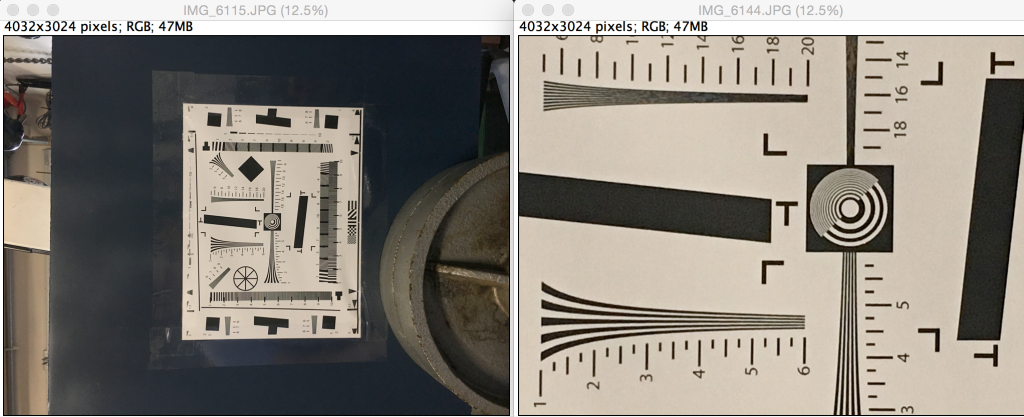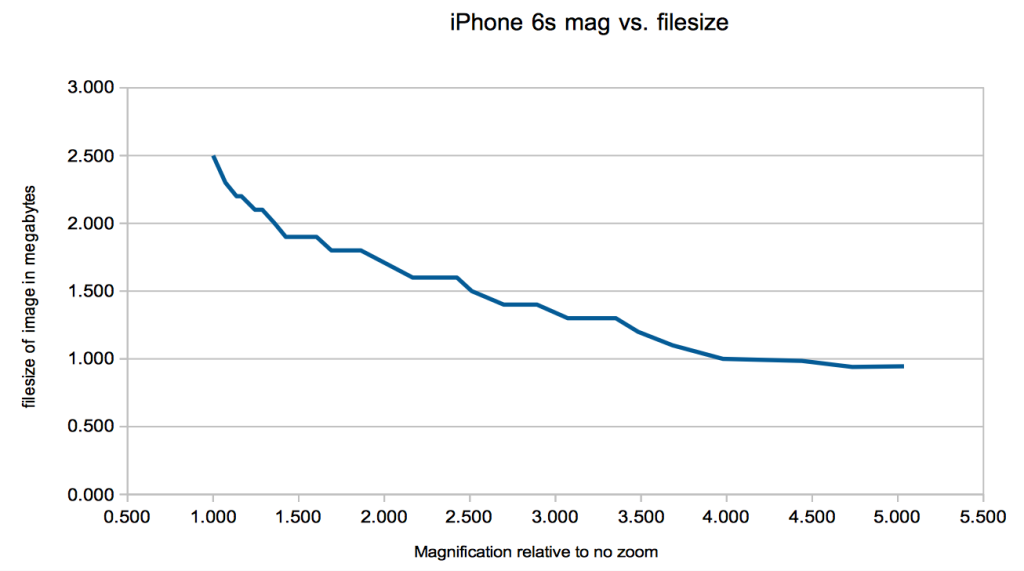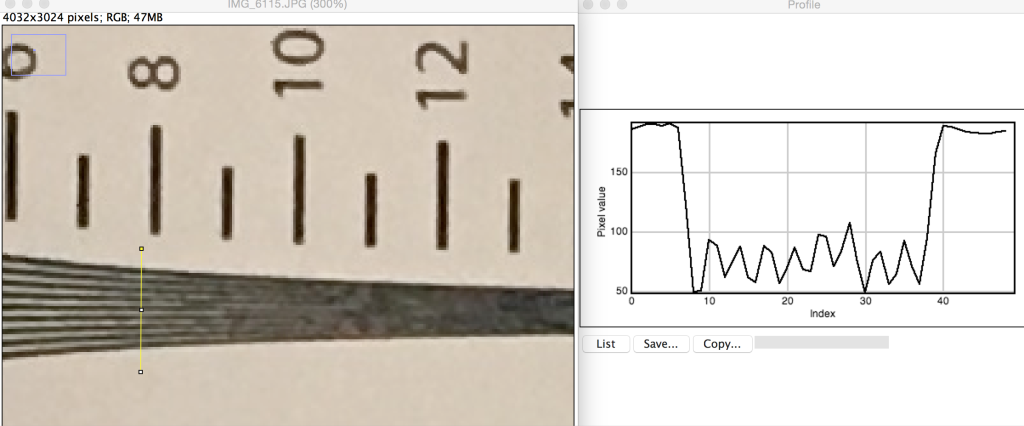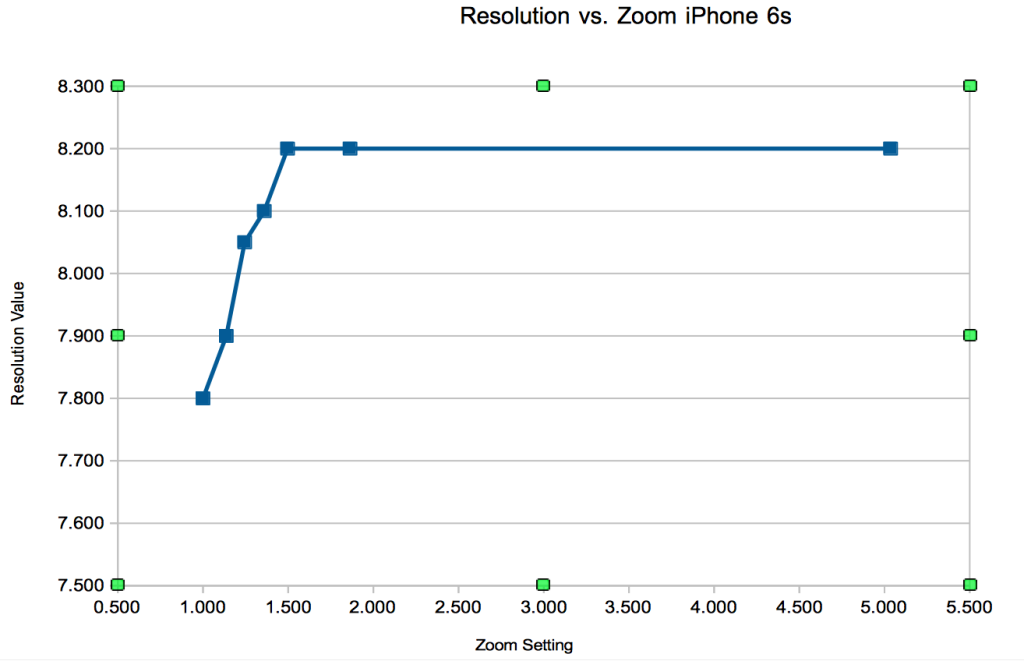Ever notice that no matter what zoom setting you use on an iPhone, the resolution of the captured image is the same? This defies convention, as normally, as a sensor is cropped digitally, the resolution of the resulting image should decrease. With Apple iDevices, this isn’t the case. The native resolution is always the same, regardless of the zoom setting used!

But some cropping MUST be going on, as there isn’t an optical zoom assembly inside the iPhone. At the same time, looking at the file sizes of captured images, it’s obvious some compression is employed, and one must assume this compression is near lossless for a given mag, so the Apple gurus must know what the true resolution of a field is, and employ a scaled compression to not exceed the inherent resolution of the captured image. Or rather, that’s what I assume is going on.
In order to test this theory, I printed an ISO standard test image (ISO 12233 @2014 to be specific), set up my iPhone 6s at a distance of 22″ from the target, and obtained a set of images, increasing in magnification from 1x, to the maximum allowed “zoom”, with as discrete steps as could be managed with touch controls. In total I captured 29 independent magnification steps.
First, here’s a look at the compression change over mag. For each image captured, I recorded the gross file size. Plotting this shows a direct inverse correlation between mag and filesize. As we know the resolution and bit depth of the file is unity, the only change must be the compression level used for a given mag setting.
So the next question is, how is maximum optical resolution (or rather “system resolution” affected by increases in magnification? The common method used to determine this for microscopy systems is the Rayleigh criterion , which basically says that maximum resolution is determined by the smallest spacing measured between two points (referred to as “minimum resolvable distance”). So in this case, we have a nice set of lines which gradually get closer together, and thinner, and which act as an excellent test standard we can use to compare maximum image resolutions.
Quick caveat here – my method of determining when minimum resolvable distance has been reached, is to use a dynamic ROI profiling tool on a line scan, and drag the line towards the thinner set of line spacings, until I cannot resolve in the ROI profile window, a measurable separation between the lines. While I admit this isn’t a hyper accurate method, I believe it to be adequate for this purpose. Anyone who might have a better solution is welcome to share!
So – here’s an example of a measurement on the lowest magnification. The steps to perform this measurement are:
- Open sample image using Fiji
- increase image zoom until horizontal resolution lines are clearly visible
- Draw vertical line
- open ROI profiling tool
- Move line towards minimum resolution until no separation is visible between one line pair.
- Move line back until pair lost is recaptured.
- Record result.
So how does resolution compare to zoom? This graph is quite interesting! Note that a subsample of the total available images was filled, once maximum resolution was reached.
What’s compelling here is that the maximum resolution is reached at a relatively low mag value of ~ 1.496x. Further magnification beyond 1.496x would appear to only reduce field of view, and corresponding filesize. What’s also interesting is that the resolution available to the phone owner can INCREASE by using zoom! This is not normally the case for cameras which employ “digital zoom”.
How can you leverage this information? The next time you want to capture a distant scene with your iPhone, and want to capture the maximum resolution available while also snagging the greatest FOV, set the zoom to around 30% of the available range, and you’ll have a good balance between resolution and field of view!
*Notes
- Zoom was calculated by comparing the size of a target object in each image relative to the lowest magnification image.
- If you’d like to view the source data collected during this experiment, it’s available here. *Images are also available, please post a request if you’d like them!
Austin




Comments
3 responses to “iPhone 6s Zoom & Resolution”
Wow this is really interesting. Good testing and experiment too!
Very interesting! So what do you think is going on? Where is that increase in resolution coming from? What kind of image processing?
My best guess is that there is a native resolution on the camera which isn’t the same as Apple’s advertised resolution. Maybe it’s higher? So when zoomed “out” the (larger) resolution is subsampled to fit the default image resolution. Then when zooming in, you begin to match the native sensor resolution. At some point (likely when the image resolution and native sensor resolution = unity) no greater resolution will be obtained, this as you increase mag and the system remaps data from a cropped image onto the native phone res, the compression can increase as the native frequency info in the image is less.
Of course, this also could just be a straight compression artifact, wherein some optimal performance balance is met as zoom reaches 1.48x. I’m not entirely certain as to the cause, but it’s quite interesting!